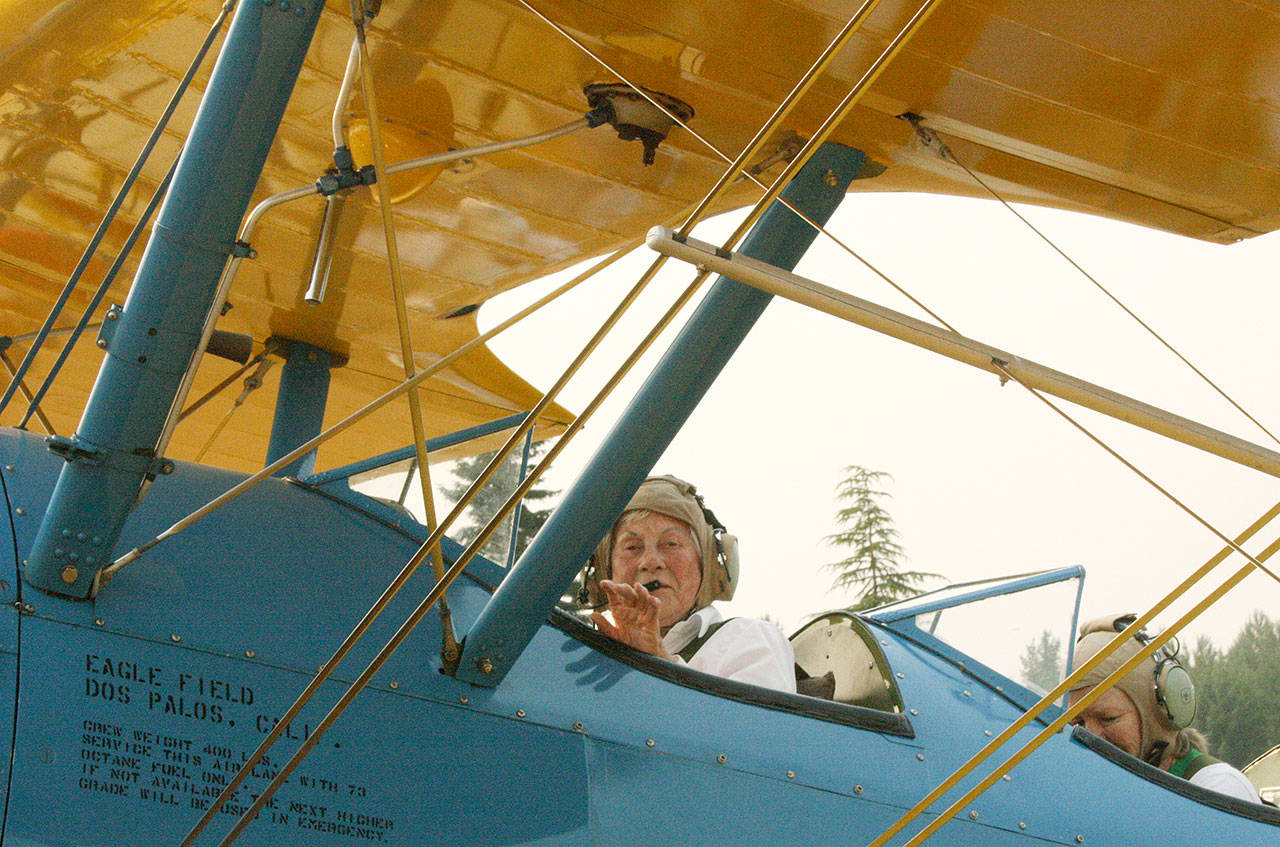Betty Dybbro sat patiently but finally had to ask, “When do we get to fly?”
The excitement was expected from the 95-year-old Dybbro, who was one of America’s “fly girls” during World War II. There’s a dwindling number of female pilots who answered their country’s call to duty during a time of war, but she remains an exuberant example of a small-but-dedicated group who took to the air.
On a recent sunny Sunday, at a rural airport east of Auburn, Dybbro was the featured guest. She was invited to a gathering of antique aircraft and fellow fliers, who took the opportunity to celebrate Dybbro’s birthday and honor her accomplishments.
Shane Mahoney organized the event, which included many of his Evergreen Sky Ranch neighbors.
There was food, jovial conversation and classic aircraft on display. But, more than anything, Dybbro wanted to get airborne. The local pilots were more than happy to oblige, taking her up first in a Piper Cub and, a short time later, a Stearman.
Dybbro, who now lives in Lacey, was a WASP, a member of the Women Airforce Service Pilots. Much of the information about the short-lived program has dimmed with history.
A brief introduction
During the height of the war years, September 1942, the United States faced a dilemma: male pilots were desperately needed on the front lines, but there were jobs to do back home that required their services and skills. Coincidentally, in the years leading to the outbreak of the war, a couple of well-known female pilots had been urging the government to allow women into military cockpits.
Famously, First Lady Eleanor Roosevelt had been lobbied and was a supporter.
But, given the social climate of the time, the military wasn’t about to put women at the controls of its aircraft. War brought about a change of heart.
The demand for male combat pilots had left the military with a shortage of experienced pilots to handle myriad duties. The decision was made to recruit women to take to the homefront skies.
Why not me?
Back home, Dybbro was a young girl who only knew farm life. “I wasn’t very worldly,” she admits, having never ventured far from the heartland. She had only once been on an airplane.
But a magazine article piqued her interest. It told of the nation’s call for female pilots being pressed into service. And Dybbro, who had dreamed about perhaps becoming a flight attendant, quickly changed her mind.
“I thought instead of just riding in an airplane, I’d fly it.”
So she scraped together the money for flying lessons – $10 per hour, a fair amount of money at the time – and took the leap.
The next step was applying for the WASP program, and Dybbro found she wasn’t alone in her dream. Records show approximately 25,000 American women applied for the force but just 1,830 were accepted. Dybbro was among those who made the cut and, most important, was one of 1,047 who graduated from the training program in Sweetwater, Texas.
Many duties, many airplanes
To allow as many men as possible to fly combat missions, the WASP were called upon to handle wide-ranging chores while flying every type of plane in the Army’s arsenal. Women pilots served as flight instructors, towed targets for gunnery training, participated in test flights and more.
Eventually, they flew more than 60 million miles and put in 300,000 flight hours.
“It was all so exciting,” Dybbro recalled.
The excitement included meeting, and marrying, a military pilot. She told her audience she had seen him flirting plane-to-plane while in the air.
One of the more thrilling duties, she said, was towing targets for gunners-in-training. While some exercises were simulated, these called for the firing of live rounds. “I always stayed in the front of the plane,” during those drills, she said.
The women who served did so at their own peril. Eventually, 38 pilots in the WASP program were killed in training or on mission flights.
Gone but not forgotten
Eventually, the high demand for combat pilots waned. Men wanted their jobs back and, as a result, the WASP program was called to a halt. It ended in late December, 1944, just weeks after the last class of female pilots graduated.
Because they were hired under Civil Service guidelines, members of the WASP force were never an official part of the military. They were brought on board in a hurry, with plans to fully militarize the program later. That never happened and, as a result, the women who flew military aircraft received no military benefits.
The current generation may be unaware of the wartime contributions made by women like Dybbro, but those who made up the WASP program are surely not forgotten.
In 1977 President Jimmy Carter signed legislation granting veteran status to the women pilots. And, on March 10, 2009, President Barack Obama awarded WASP pilots the Congressional Gold Medal. Approximately 300 were alive at the time, with 12 residing in Washington; the rest were awarded posthumously.
Dybbro brought her medal to the Enumclaw gathering, along with a desire to return to the sky.
Talk to us
Please share your story tips by emailing editor@kentreporter.com.
To share your opinion for publication, submit a letter through our website https://www.kentreporter.com/submit-letter/. Include your name, address and daytime phone number. (We’ll only publish your name and hometown.) Please keep letters to 300 words or less.

